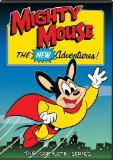| Reviews & Columns |
|
Reviews DVD TV on DVD Blu-ray 4K UHD International DVDs In Theaters Reviews by Studio Video Games Features Collector Series DVDs Easter Egg Database Interviews DVD Talk Radio Feature Articles Columns Anime Talk DVD Savant Horror DVDs The M.O.D. Squad Art House HD Talk Silent DVD
|
DVD Talk Forum |
|
|
| Resources |
|
DVD Price Search Customer Service #'s RCE Info Links |
|
Columns
|
|
|
Mighty Mouse: The New Adventures - The Complete Series
THE SHOW:
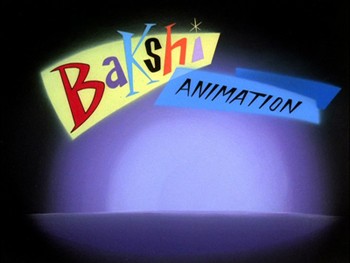
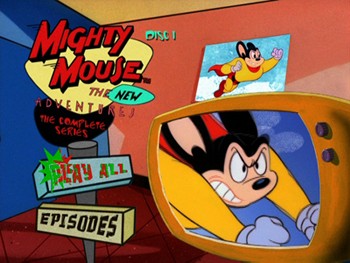
Mighty Mouse: The New Adventures premiered to much ballyhoo in the fall of 1987. I was 15 years old and already a big animation fan, including being a fan of the original Mighty Mouse shorts that had been produced by Terrytoons. There was a lot of attention being paid to the series in the comics and pop culture press because it was being produced by Ralph Bakshi, a pioneer in adult animation, having made such films as Fritz the Cat, The Lord of the Rings, and Fire & Ice, movies I had largely not seen but that I was more than aware of. The advance word was Mighty Mouse: The New Adventures was going to be something different, something revolutionary in terms of Saturday morning children's programming.
And it was, for a time. The show definitely looked different. The animation was as limited as any other program in the CBS line-up that year, but the style of the drawing made it stand out. The creative team made up for the draw-backs in technology by making the series look crazy, using the imposed simplicity to make something noteworthy for how exaggerated it was. This exaggeration would be matched by the scripting style. The concept of the show was to take the famous cartoon mouse, who had begun his career as a parody of Superman, and go wild with it. Mighty Mouse: The New Adventures was irreverent and self-referential, regularly breaking the fourth wall. It skewered standard comic book stories, as well as cliché cartoon plots. Mighty Mouse was still a hero, but he was also kind of a big lunkhead. His girlfriend, Pearl Pureheart, was his alter-ego's boss at a factory that made rodent-free cat food. His villains were weird characters like Petey Pate, a cat who had lost his marbles because everyone made fun of his bald head, and The Cow, a bovine bad guy who championed dairy rights. Mighty Mouse lived in Mouseville, and other animals had their own towns, too. It was a strange yet unlimited world.
19 episodes, each containing two shorter cartoons, were produced over the next 18 months--a rather slow pace for a network show, particularly when syndicated shows like G.I. Joe had been cranking out daily cartoons in big chunks. It used to drive me nuts waiting for new Mighty Mouse episodes. I'd get up on Saturday, tune in, and wait and see if the pre-show teaser would be something I had never seen before. Then controversy hit. Professional killjoy and all-around uptight jerk Reverend Donald Wildmon mounted one of his many crusades against free expression based on a 3-and-a-half second shot in the 7th episode. In the cartoon "The Littlest Tramp," Mighty Mouse sniffs a crushed flower that had been given to him by the orphan Polly Pineblossom, and Rev. Wildmon insisted that Ralph Bakshi was telling kids to take cocaine. The writing was starting to be on the wall. The show disappeared the following fall, only to resurface briefly in reruns in the early 1990s, likely to capitalize on the success of Ren & Stimpy--itself the real breath of fresh cartoon air that Mighty Mouse: The New Adventures had intended to be. The style of that show was like the full realization of this one's aesthetics--which was no surprise, since Ren and Stimpy's creator, John Kricfalusi, was a main designer and director on The New Adventures.
John K. wasn't the only one to move on to greater fame after serving on Bakshi's staff. I'm surprised today to discover that Bruce Timm (Batman: The Animated Series and the driving force behind most DC Comics animated vehicles), Jim Reardon (a writer and director for The Simpsons, co-writer of Wall*E), and Andrew Stanton (director of Wall*E, writer of Monsters, Inc.) all got there start here. This should have only added to the considerable legend that Mighty Mouse: The New Adventures developed over the years. And make no mistake, this show has achieved a definite cult status, attaining a mythic reverence by virtue of its being unavailable for so long. It became the sort of thing guys like me talked about, and a few others had tapes of, but that a lot of people had never really seen.
Which raises the question, now that Mighty Mouse: The New Adventures has returned to pop culture via this thing we call DVD, does it live up to its reputation? Or is this going to be another case of my childhood disappointing me, the way I discovered Galaxy High, which debuted a year before New Adventures, was not all I remembered it to be?
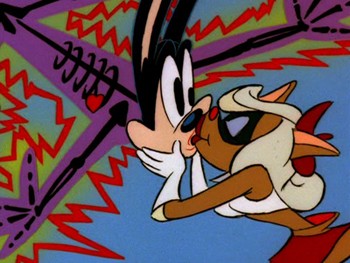
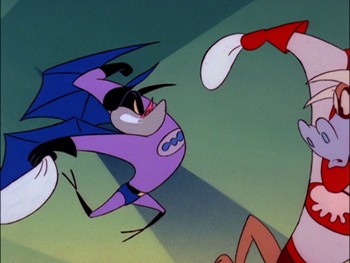
The answer is yes and no. Yes, because it's clear how out of bounds the cartoon was for the mid-80s and some of the segments are still genuinely funny. No, because what made it so crazy then doesn't really hold up as innovative now, and the quality of the show is so all over the place, it's hard to look at Mighty Mouse: The New Adventures and judge it as a completely successful whole.
Some of these cartoons are out-and-out awful. Any of the shows that focus entirely on Mighty Mouse's orphan sidekick, Scrappy can pretty much be skipped. "Witch Tricks" (episode 2) or "Scrap-Happy" (episode 3), for instance, abandon the superhero format to show the precocious (read: obnoxious) mouse doing battle with a wicked witch or getting kidnapped in a cat carnival, and these are boring and conventional in proportion to how off their rocker some of the better segments are. There are also some fairly appalling fill-in episodes, such as "Mighty's Musical Classics" (episode 6) or "Animation Concerto" (episode 10), which merely cut up a bunch of old Terrytoons to create cheap music videos. Though vintage Terrytoons are used in a clever way in episode 11's "The Ice Goose Cometh" and episode 13's "Stress for Success," utilizing older shorts for dream sequences, "Anatomy of a Milquetoast" (season 2, episode 2) and "Mighty's Tone Poem" (episode 2.6) are clip shows recycling footage from The New Adventures (albeit with altered dialogue).
The first major stand-out of the series is in episode 3, the cartoon "Night of the Bat-Bat." This Batman send-up pits Bruce Vein and Tick the Bug Wonder against their nemesis the Cow, and the jokes are still strong even though this parody was well ahead of the ultra-serious direction the Batman movies have taken over the years. The controversial "The Littlest Tramp" (episode 7) is also pretty good, playing on treacle-infused stories like "The Little Match Girl." The villain Big Murray is introduced in that one, and it's pretty clear that he is a John Kricfalusi creation. The bulging eyes, the stretched sinews, the raspy voice--there's no mistaking it. The same episode also has "Puffy Goes Berserk," a giant-kitty story that is a fun riff on MGM-era Tex Avery.
DVD 2 starts off strong with the lead short in episode 8, the Justice League-spoof, "The League of Super-Rodents." In it, the Cow takes on an entire team of superpowered vermin while Mighty Mouse is romanced by Madame Marsupial. The rest of the disc stumbles along okay enough, but doesn't really get hot again until the amazing episode 12. "Mighty's Benefit Plan" offers a twisted version of Alvin and the Chipmunks called Elwy and the Tree Weasels, and the second cartoon, "See You in the Funny Papers," has a bunch of Dick Tracy-style villains come to life. The bad guys are cleverly designed, and the whole show is given a comic-strip look, complete with printed dots on all the buildings. The first half of episode 13 is also fantastic. "Heroes and Zeroes" shows us the old Terrytoon super team, the Mighty Heroes, in their middle-aged role as accountants. (Ralph Bakshi worked at the Terrytoon studios, including being part of the Mighty Heroes production staff. "The Ice Goose Cometh" also updates the old characters Gandy Goose and Sourpuss, and it has a cameo by Deputy Dawg. All three will return later in the series, along with some other familiar faces.)
By this point, the Bakshi Studio had hit a real creative stride. The final disc is the last six episodes, what is considered season 2, and the new shows are more focused and yet more unbridled at the same time. (Perhaps it's the almost complete absence of Scrappy that makes the difference....) Within the first two episodes, we get references to the Red Scare, Pee-Wee Herman, "The Honeymooners," Woody Allen, and Perry Mason. Oil Can Harry, Mighty Mouse's original villain, returns as Pearl's stalker, there are references to Gandy and Sourpuss being more than friends, and there is even a joke that suggests a dream version of Pearl cheated on Mighty Mouse with the Cow--nothing overt, mind you, stuff that would go right over the heads of youngsters but that will entertain the older viewers who happen to get caught up in the madness, the way most classic cartoons always have.
Clearly, the animators have gotten their dander up, and a couple of years before The Simpsons regularly bit the hand they fed by taking potshots at their network, Mighty Mouse: The New Adventures trains its sights on television and the entertainment business in general. "Snow White and the Motor City Dwarves" (episode 2.4) has Mighty in a pitch meeting with an uncreative television executive, whereas "A Star is Milked" (episode 2.6) details production of the Mighty Mouse biopic. More pointed, though, are "Mouse and Supermouse" (episode 2.5), in which Petey Pate creates a better Mighty Mouse thanks to the science of market research, and "Don't Touch that Dial" (episode 2.4) has the Mouse on a tour of other Saturday morning shows, ending with Mighty Mouse taking on some humorless anime toy tie-ins. In both, the point is that cartoons are being made less for the fun of it, and more for their commercial potential, leading to bland retreads and over-long advertisements. I don't know if Bakshi and the rest were aware they were on their way out, but they were going to make sure they scorched the earth either way.
Because for all of its flaws, at least Mighty Mouse: The New Adventures was never bland, never beholden to anybody. I found myself enjoying less of the episodes than I had hoped to, but the last eight or so are really on the mark, with true moments of brilliance intermittently in the first eleven. One thing that the parodies in "Don't Touch that Dial" make clear is that there was no other show like this one. The rapid-fire humor was something new to kid's TV and would be endlessly imitated after. The rise of original content on both Nickelodeon and Cartoon Network owe a lot to Ralph Bakshi's Saturday morning experiment, which kickstarted a whole new generation of cartooning.
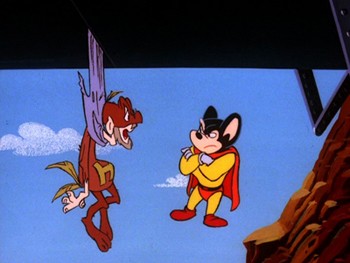
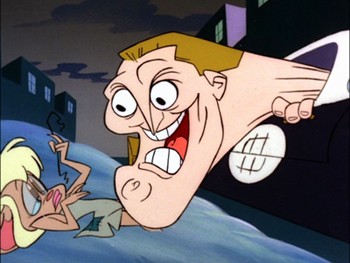
THE DVD
Video:
Having been produced for network television in the 1980s, Mighty Mouse: The New Adventures was of course created to be seen in a full screen 4:3 aspect ratio. The source prints for these discs are surprisingly good, with most of the cartoons looking bright and clear. Some of the quality varies, you will see some dirt and scratches on various episodes, but nothing too awful. The only persistent problem is some interlacing. In fact, one could argue that some of these transfers are too good; the clarity reveals flaws in the animation.
All 19 cartoons are, for the most part, as they were broadcast. The live-action ending for "Wedlock Whimsy" is absent, replaced by an animated insert created in case future broadcast rights for the images of the people in the live action portion could not be secured. Some of the live footage appears in the documentary, but you'll note some faces in the archival footage are blurred out, so the old fears were justified. The animated ending is the same, including the same audio, just of a slightly different flavor than the anarchic shift out of the cartoon.
Sound:
The Dolby Digital mono mix has excellent volume quality and is free of distortion.
English Closed Captioning is provided.
Extras:
Season 1 of Mighty Mouse: The New Adventures is spread over two discs, with 7 episodes on the first and 6 on the second. The final 6 episodes of Season 2 are on the third disc, along with extra features. The three discs are packaged in a standard-sized clear plastic case with a hinged interior tray. The back side of the cover, which is visible through the clear plastic, has episode information printed on it. All the discs have a "play all" function, or you can choose one episode at a time. The latter option also allows you to select episode-specific teasers that go with each show, which are basically short montages that lead into the program and gave viewers a heads-up on what was coming.
Two episodes have audio commentaries. Episode 2 (Disc 1) has John Kricfalusi and writer Tom Minton talking about "The Night of the Bat-Bat," while Minton joins animators Kent Butterworth and Mike Kazaleh for the second segment, "Scrap-Happy." Kricfalusi and Minton return to talk about "Mighty's Benefit Plan" on Episode 12 (disc 2), while the other three discuss "See You in the Funny Papers" for the same episode.
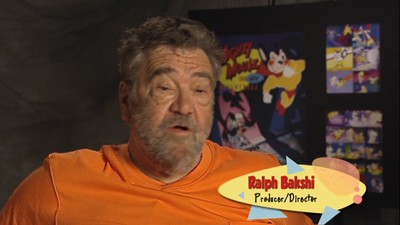
DVD 3 has three of the older Mighty Mouse cartoons so fans can compare and contrast and look at the evolution of the character. They are "He Dood it Again" from 1943 and "Gypsy Life" from 1945, and the later 1960 cartoon "The Mysterious Package," which Ralph Bakshi was an animator on.
The third disc also has the program "Breaking the Mold: The Re-Making of Mighty Mouse," a look back at the series with new interviews with Bakshi, Kricfalusi, Timm, Stanton, Reardon, Butterworth, Minton, Kazaleh, and a bunch of others from the original crew. This half-hour featurette is pretty awesome, giving the crazy history of this show, discussing the creative impulses that were powering it, and showing archival footage of the creators, storyboards, and designs. Even the Wildmon controversy is gone over, and it appears to still baffle the team, especially since, as Kricfalusi notes, there was plenty of intentionally subversive stuff for people to get upset about if they wanted to.
There are trailers at the start of DVD 1, but the initial screen asks you if you want to bypass them, which is darn polite of them, I think.
FINAL THOUGHTS:
It was a bit rough going at first. I wasn't instantly transported back to my younger days the way I had hoped when I popped in Mighty Mouse: The New Adventures - The Complete Series, but after some shakes in the start (go away, Scrappy!), this irreverent revamp of the old cartoon hero turned into a gonzo assault on media culture in the latter third of its 19 episodes. Put together by a bevy of new artistic talent, folks that would come to define animation in the decades to come, the more unmoored Mighty Mouse: The New Adventures became, the more hilarious. This new set finally brings this late '80s cult favorite back to general audiences, and if nothing else, get the last disc to see the best set of episodes and the new documentary on the making of the show. Recommended.
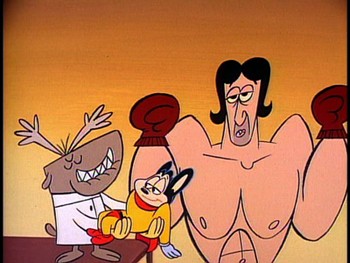
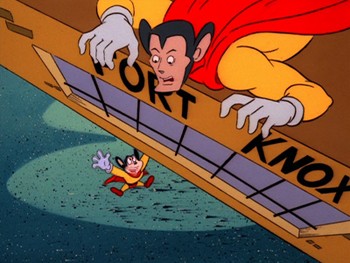
Jamie S. Rich is a novelist and comic book writer. He is best known for his collaborations with Joelle Jones, including the hardboiled crime comic book You Have Killed Me, the challenging romance 12 Reasons Why I Love Her, and the 2007 prose novel Have You Seen the Horizon Lately?, for which Jones did the cover. All three were published by Oni Press. His most recent projects include the futuristic romance A Boy and a Girl with Natalie Nourigat; Archer Coe and the Thousand Natural Shocks, a loopy crime tale drawn by Dan Christensen; and the horror miniseries Madame Frankenstein, a collaboration with Megan Levens. Follow Rich's blog at Confessions123.com.
|
| Popular Reviews |
| Sponsored Links |
|
|
| Sponsored Links |
|
|
| Release List | Reviews | Shop | Newsletter | Forum | DVD Giveaways | Blu-Ray | Advertise |
|
Copyright 2024 DVDTalk.com All Rights Reserved. Legal Info, Privacy Policy, Terms of Use,
Manage Preferences,
Your Privacy Choices | |||||||









